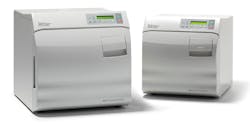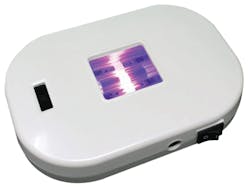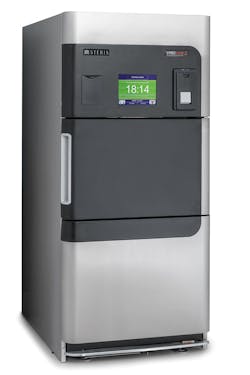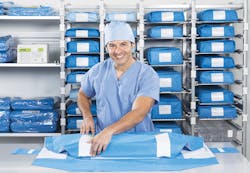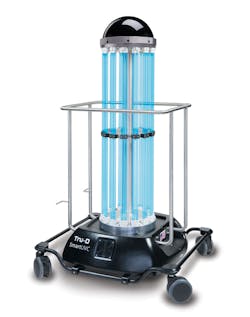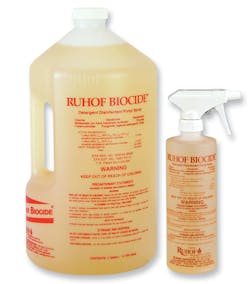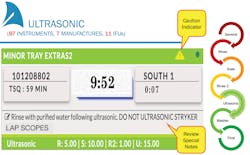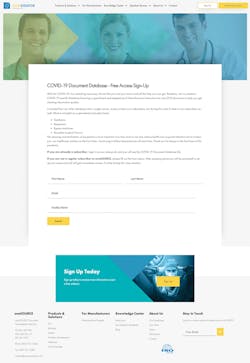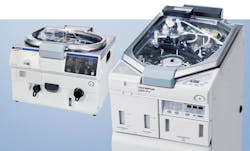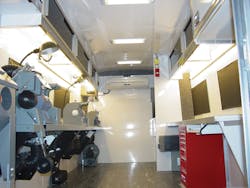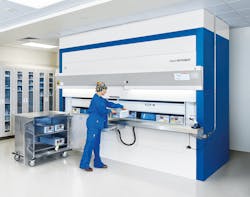The novel coronavirus (COVID-19) pandemic has touched us all. We live and function in a much different world. Together we unite to stay home, social distance and take extra precautions to clean, disinfect and protect against infection.
Great appreciation is shown for frontline first responders, nurses, doctors and all other healthcare workers who sacrifice and risk their health to care for our communities. Perhaps one group of unsung healthcare heroes is the sterile processing department (SPD). The SPD leaders, staff and technicians work during routine and heightened periods of care to clean and disinfect surgical items and help prevent patient infections.
In this article we examine the current climate of COVID-19, healthcare and infection prevention, as well as the best practices, tools and technology used in the sterile processing field today.
Pathways of contamination and disease
Organisms, viruses and other pathogens can easily contact and spread through equipment, furniture, surfaces, people and other items in hospitals and other settings. COVID-19 was discovered to live for hours or even days in environments, laying the ground for infection.
“The virus that causes coronavirus disease 2019 (COVID-19) is stable for several hours to days in aerosols and on surfaces, according to a new study from National Institutes of Health, CDC, UCLA and Princeton University scientists in The New England Journal of Medicine. The scientists found that severe acute respiratory syndrome coronavirus 2 (SARS-CoV-2) was detectable in aerosols for up to three hours, up to four hours on copper, up to 24 hours on cardboard and up to two to three days on plastic and stainless steel. The results provide key information about the stability of SARS-CoV-2, which causes COVID-19 disease, and suggests that people may acquire the virus through the air and after touching contaminated objects,” reported the Centers for Disease Control and Prevention (CDC).
The COVID-19 coronavirus is just the latest in a host of infectious diseases that are bringing focus and attention to disinfection and infection prevention. Now, more than ever, all healthcare providers need to be well equipped and expertly trained to handle sterilization and instrument processing in their practice, expresses Darwin Asa, Midmark Corporation.
“As the COVID-19 pandemic and antimicrobial resistance “superbugs” loom ever larger in headlines, the need for infection control across health systems has reached a new urgency. Keeping patients and staff safe is at the heart of any effective infection control measure, so a better understanding and adherence to instrument processing best practices is truly essential for every facility. Midmark recommends the instrument processing best practices established by the CDC.”
Midmark’s instrument processing solutions include automatic cleaning, sterilization and medical-grade casework, notes Asa. “Our technologies are engineered for simplicity to help ensure compliance with applicable standards and best practices. For example, Midmark’s updated line of tabletop sterilizers is designed to be safe and dependable with stainless-steel construction and third-party ASME certification that helps contain contamination and maximize the efficiency of instrument sterilization processes.”
In an ideal world, Dr. Lucia Mokres, Chief Medical Officer, Far UV Technologies, Inc., hopes to work toward wiping out infectious outbreaks.
“Our ambitious goal is to rid the world of future pandemics or epidemics by creating autonomous persistent disinfection devices that can immediately assist in containing the inevitable emergence of disease that can be spread on surfaces or through the air. These could be situated alongside normal lighting in medical, elderly care, industrial, commercial, retail and consumer buildings to dramatically reduce or eliminate the incidence or spread of common colds and flus, chemically-resistant microbes (MRSA or C Diff) that can result in hospital-acquired infections or more virulent diseases, such as the coronavirus, SARS, MERS or Ebola.”
Combatting infection
No doubt, COVID-19 has certainly changed healthcare as usual. A shortage of respirators, ventilators, hand sanitizers, masks and other medical care and personal protective equipment has left many hospitals and healthcare workers without the supplies they need for safety and patient care. Several organizations set forth recommendations and guidelines for care, disinfection and sterile processing in facilities.
American College of Surgeons advised, “The College recommends hospitals, health systems, and surgeons enact plans to minimize, postpone, or cancel elective operations at the current time until we are confident that our health care infrastructure can support a potentially rapid and overwhelming uptick in critical patient care needs.”
In regard to handling COVID-19-contaminated items and disinfection in healthcare settings, International Association of Healthcare Central Service Materiel Management (IAHCSMM) noted guidance from Occupational Safety and Health Administration (OSHA), including, “Follow standard practices for high-level disinfection and sterilization of semi-critical and critical medical devices contaminated with COVID-19, as described in the CDC Guideline for Disinfection and Sterilization in Healthcare Facilities, 2008.”
Additionally, “At this time there is no EPA-approved list of disinfectants effective against COVID-19. COVID-19 is a coronavirus and highly susceptible to inactivation by many commonly used disinfectants. Currently, OSHA recommends following SARS disinfection practices for environmental areas contaminated with COVID-19.”
“Sterile Processing departments need to be informed in situations like these in order to understand if it is truly necessary to implement new processes and procedures. In most cases, continuing to consistently follow manufacturers’ instructions for use will provide the best outcome. It is also important to be informed about proper use of PPE, not just during a pandemic, but always utilizing PPE that is appropriate for the task at hand, as well as appropriate removal of PPE to prevent self-contamination,” Owens said.
Watkins called out STERIS’ reprocessing sinks, ultrasonics, washers, accessories, and sterilizers for instrument cleaning, including the V-PRO sterilizer and maX processing line, saying, “STERIS covers the complete reprocessing journey of an instrument. Hands down, the V-PRO meets low temperature sterilization requirements like nothing else in the industry. maX Throughput processes 11 lbs. (5 Kg.) of non-lumen devices in 16 minutes or processes 50 lbs. of non-lumen devices in 28 minutes.”
Halyard’s sterile processing, reprocessing and PPE supplies, equipment and educational resources help protect the safety of SPD personnel and keep instruments clean, shared Joseph Hannibal, Marketing Director for Sterilization, Surgical and Infection Prevention, Halyard.
“In a recent Sterility Maintenance Study, HALYARD Sterilization Wrap was shown to maintain 100% sterility post-sterilization versus rigid sterilization containers. In addition, Halyard provides its Knowledge Network, a free dynamic collection of educational programs designed to provide the insights and information on relevant healthcare issues that healthcare professionals need to improve staff competency, safety, infection prevention and patient outcomes.”
The Tru-D SmartUVC disinfection robot is used in hundreds of hospitals across the U.S. in patient rooms, ORs as well as Sterile Processing departments to ensure a clean, germ-free environment, highlighted Brewer.
“Tru-D delivers one automated, measured dose of UVC to consistently disinfect a room, resulting in the ability to document disinfection results after each Tru-D room treatment. Used in the first-ever randomized clinical trial on UVC disinfection, the Benefits of Enhanced Terminal Room-Disinfection (BETR-Disinfection) study, Tru-D has been shown to significantly reduce bioburden and epidemiologically-important pathogens, which can lead to a reduction in colonization and infections in hospital settings with 93% compliance of standard disinfection protocols.”
Douglas J. MacKay, The Ruhof Corporation points to their RUHOF BIOCIDE DETERGENT DISINFECTANT PUMP SPRAY as another tool to fend off viruses and other pathogens.
Following the IFU
A best practice for SPDs is to follow the manufacturers’ instructions for use (IFU) to ensure proper cleaning, but Andy Petrovich, President & CEO, Petriss, sees that area lacking with facilities.
“Every hospital in America is falling short in following the validated OEM IFU every day. Data has shown and proved that sterile processing departments are non-compliant between 35%-70% on every tray being processed through the department. Instruments are simply not being cleaned and disinfected appropriately before sterilization. This clearly attributes to potential SSIs.”
The Petriss BLUEfin decontamination intelligence software projects up-to-date information for managing the cleaning process of instruments.
Petrovich described, “BLUEfin calculates, communicates and documents Real-Time IFU details to sterile processing professionals for all instruments, manufacturers and trays, 24/7. Imagine every staff member receiving the same timer, IFU details, instrument tray expectations, pictures and training video! By providing this powerful information to the end users, they will be able to produce consistent outcomes that not only impact patient safety, but also protect the sterile processing professionals.”
Other resources for IFUs and instrument cleaning are oneSOURCE’s Surgical Instrument and Equipment database and new COVID-19- database with IFUs related to ventilators, respirators, bypass machines and reusable surgical gowns, reports Heather Thomas, CMO & Executive Vice President of Sales & Marketing, oneSOURCE.
“Tools like oneSOURCE are imperative when it comes to providing healthcare workers with the resources to fight diseases like COVID-19,“ said Thomas. “We recognize the severity and struggle our world is facing and felt it was our responsibility to arm those on the frontlines of this medical crisis with ways to effectively sterilize, clean and execute their duties in the safest way possible.”
Christian Berling, HEINE USA Ltd., urges manufacturers to play a role in educating SPDs on IFUs.
“From the perspective of an instrument manufacturer, I believe that the best practices and standards would be to hold manufacturers accountable for better training and IFUs. Manufacturers need to be held to a higher standard, especially within SPD. Manufacturer representatives need to know their hygienic reprocessing information, equipment and cleaning solutions, and have information on process validation. Manufacturers should also be a resource for the hospital when they are being audited.”
“Our new EasyClean laryngoscope handle is the only LED handle on the market that can be sterilized without any disassembly. The handle is sealed and waterproof and can be sterilized without removing the batteries or illumination system. It is also the only handle on the market with a validated low-level surface disinfection process,” Berling stated.
The work of SPDs during COVID-19 and every day should be guided by IFUs and the latest healthcare regulations, addressed Melinda Benedict, MS, CIC, CFER and Lynn Burbank, Olympus Corporations of the Americas.
“The best practice for reprocessing during the COVID-19 pandemic is to maintain evidence-based practice (EBP) that has been validated by regulatory agencies and product manufacturers. In reprocessing, staff should consider that all surfaces are contaminated or have the potential to be contaminated and maintain universal precautions. The type of micro-organism does not change the need to: don PPE, manually clean instruments and devices inclusive of pre-cleaning within one hour of the procedure, utilize compatible reprocessing methods and adhere to the product IFU in order to ensure patient safety.”
Olympus’ medical devices, such as their Olympus OER-Pro or OER-Mini automated endoscope reprocessors, are used across therapeutic practice areas.
Benedict and Burbank highlighted, “Automation in reprocessing has greatly impacted how efficiently and effectively infections are eliminated on endoscope surfaces. The Olympus OER-Pro or OER-Mini are intended for use in cleaning and high-level disinfection of heat-sensitive Olympus flexible endoscopes and their accessories. The OER units offer several automated features designed to prevent transmission of microbes.”
Helping keep surgical instruments and equipment clean and in working order and rotation is Northfield Medical.
“We service stainless steel instruments, rigid endoscopes, power tools, video cameras, flexible endoscopes, TEE probes, and so much more. We even clean autoclaves and OR tables and repair casters and case carts. We focus on providing repairs that return devices to their original form, fit and functionality while also providing education and tools to prevent devices from breaking in the first place. Physicians and care-providers depend on their tools functioning correctly to be able to do their jobs well, ” explained Michael Matthews, Director, Clinical Education & Training, Northfield Medical.
Instrument classification, tracking and storage
Another important step for SPDs is maintaining instructions and identification of instruments for optimal tracking, preferably in an online system, which can help reduce hospital inventory, prevent infection and reduce labor costs, raises Dana Curtis, DGSHAPE Corporation.
“Best practices for healthcare facilities include Universal Device Identification (UDI) part marking of each surgical tool or medical device and a thoroughly documented procedures manual. Tribal knowledge is dangerous in any organization, but especially when there is threat of danger to the patient’s health. The best method for maintaining standards is to publish the steps of the sterile process in a central location. Making that process digital increases efficiency and productivity exponentially.”
He continued, “Eirthemis is a complete traceability system for all devices in the facility. Tracing can be done by photo or QR code. The software logs location, usage/maintenance/repair history, and tracks reprocessing per employee, surgical procedure, and department. MPX-95 permanently marks metal instruments without removing material or altering device function. MR-1 scanner is touchless and ultra-high resolution.”
Ken Shaw, President of the Americas, Nanosonics, Inc., agrees that standardized classification of instruments benefits care, noting, “The need for standardized reprocessing based on the Spaulding classification has never been more important to protect patients. Notably, the Ultrasound IP Toolkit brings together the principles from our national standards and federal guidelines to help facilities manage the safe reprocessing and use of ultrasound.”
Another critical part of SPDs is safe storage of sterilized instruments to decrease chances of contamination, expresses David Phillips, Marketing Manager, Hänel Storage Systems.
“The best practice of all is to ensure that as few people as possible come into contact with supplies that have been sterilized. Sterile trays and supplies should be protected from risk of contamination by stringently adhering to AAMI ST79 Sterile Storage standards, in particular the three-touch rule, as well as be available at an ergonomically-correct pick point for all product regardless of size and weight, and follow a logically-organized methodology for all products in storage.”
With Hänel’s Rotomat automated vertical carousel, he explained, “These machines condense the storage capabilities of four or more racks into a much smaller footprint, making unprecedented use of vertical space. Items are brought to the user, and Hänel’s inventory management software ensures that supplies are used in a timely manner, without the risk of shortages or expired items. Within the fully-enclosed cabinet of a Rotomat, sterile supplies are not only protected from over-handling and contaminants, but also from unauthorized access.”
COVID-19 and other health crises reinforce the need for accuracy and efficiency in instrument identification and delivery. Kevin Anderson, BSN, RN, CNOR, CSSM, CRCST, CHL, CIS, CER, Clinical Education Coordinator, Healthmark Industries, points to Healthmark’s cleaning verification, container, labeling and cleaning products.
He stated, “Our customers are responsible for delivering safe, ready-to-use medical devices to the patient. Our products help them do that. We are experiencing extraordinary challenges right now with the COVID-19 pandemic. I know, from my years of working for a major healthcare system, one of the greatest challenges during a crisis is communication. Healthmark produces a complete line of labeling and signage products. These products can help communication with coworkers, patients and the public.”
Vendor Listings, SPD & Critical Care Product Spotlights
Refrerences
1. New coronavirus stable for hours on surfaces, https://www.nih.gov/news-events/news-releases/new-coronavirus-stable-hours-surfaces
2. American College of Surgeons releases recommendations for surgical management of elective operations during COVID-19 pandemic, https://www.facs.org/media/press-releases/2020/covid-031320
3. IAHCSMM Resources: COVID-19 (Coronavirus), https://www.iahcsmm.org/resources-covid19
4. Sterility Maintenance Study, Harry L. Shaffer MS, Delbert A. Harnish MS, and Brian K. Heimbuch MS
5. Sterile Processing Platform, oneSOURCE, Creates Free Database to Address COVID-19 Pandemic, https://www.onesourcedocs.com/2020/03/31/sterile-processing-platform-onesource-creates-free-database-to-address-covid-19-pandemic/
About the Author

Ebony Smith
Ebony Smith was previously Managing Editor for Healthcare Purchasing News.

